Employee Retention: A Case Study of Staff Motivation Schemes at M&S
VerifiedAdded on 2023/06/18
|11
|2100
|339
Case Study
AI Summary
This case study investigates the influence of staff motivation schemes on employee retention at Marks & Spencer, a well-established retail company. It aims to understand the concept of staff motivation, determine effective motivation practices for employee retention, and analyze the significance of these schemes in enhancing company performance and productivity. The research employs a positivism research philosophy and a survey strategy for data collection, utilizing both primary and secondary data sources. The literature review covers intrinsic and extrinsic motivation, incentives, rewards, and the importance of a positive work environment. The study concludes that talent management and staff motivation are crucial for business success, leading to less staff turnover, increased employee relationships, and improved work quality. This report provides valuable insights into how organizations can leverage staff motivation to improve employee retention and overall performance.

Unit 11
Paraphrase This Document
Need a fresh take? Get an instant paraphrase of this document with our AI Paraphraser
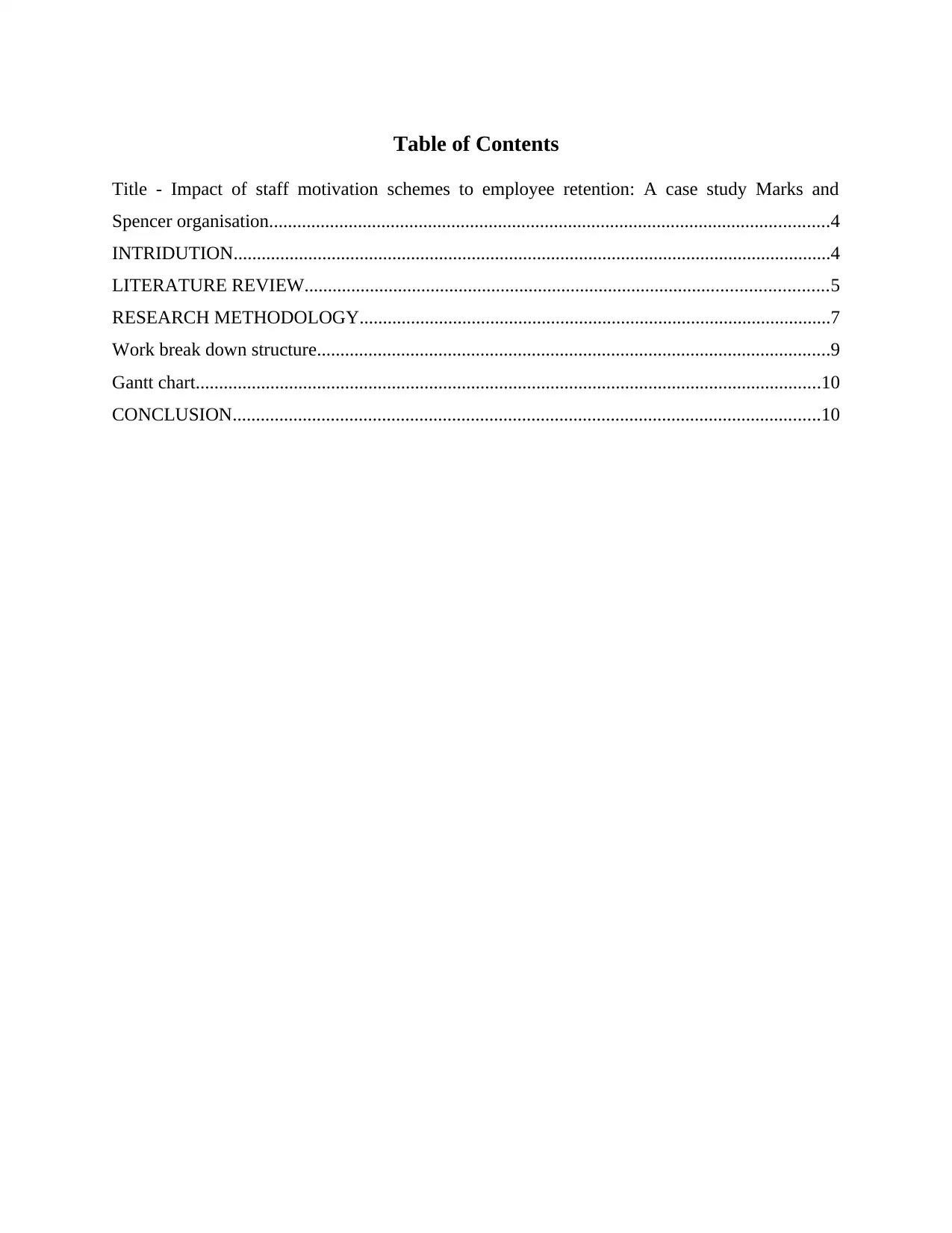
Table of Contents
Title - Impact of staff motivation schemes to employee retention: A case study Marks and
Spencer organisation........................................................................................................................4
INTRIDUTION................................................................................................................................4
LITERATURE REVIEW................................................................................................................5
RESEARCH METHODOLOGY.....................................................................................................7
Work break down structure..............................................................................................................9
Gantt chart......................................................................................................................................10
CONCLUSION..............................................................................................................................10
Title - Impact of staff motivation schemes to employee retention: A case study Marks and
Spencer organisation........................................................................................................................4
INTRIDUTION................................................................................................................................4
LITERATURE REVIEW................................................................................................................5
RESEARCH METHODOLOGY.....................................................................................................7
Work break down structure..............................................................................................................9
Gantt chart......................................................................................................................................10
CONCLUSION..............................................................................................................................10

⊘ This is a preview!⊘
Do you want full access?
Subscribe today to unlock all pages.

Trusted by 1+ million students worldwide
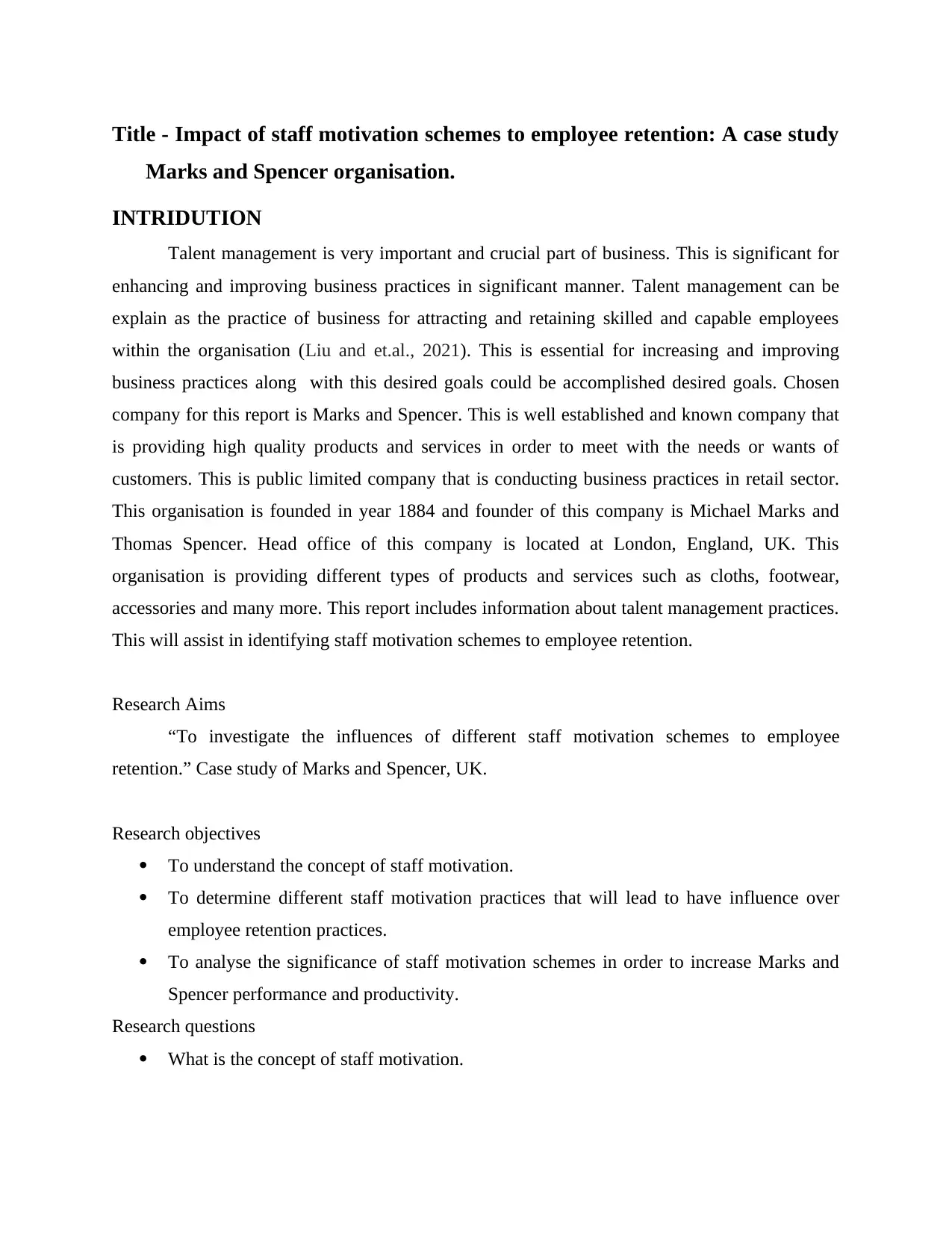
Title - Impact of staff motivation schemes to employee retention: A case study
Marks and Spencer organisation.
INTRIDUTION
Talent management is very important and crucial part of business. This is significant for
enhancing and improving business practices in significant manner. Talent management can be
explain as the practice of business for attracting and retaining skilled and capable employees
within the organisation (Liu and et.al., 2021). This is essential for increasing and improving
business practices along with this desired goals could be accomplished desired goals. Chosen
company for this report is Marks and Spencer. This is well established and known company that
is providing high quality products and services in order to meet with the needs or wants of
customers. This is public limited company that is conducting business practices in retail sector.
This organisation is founded in year 1884 and founder of this company is Michael Marks and
Thomas Spencer. Head office of this company is located at London, England, UK. This
organisation is providing different types of products and services such as cloths, footwear,
accessories and many more. This report includes information about talent management practices.
This will assist in identifying staff motivation schemes to employee retention.
Research Aims
“To investigate the influences of different staff motivation schemes to employee
retention.” Case study of Marks and Spencer, UK.
Research objectives
To understand the concept of staff motivation.
To determine different staff motivation practices that will lead to have influence over
employee retention practices.
To analyse the significance of staff motivation schemes in order to increase Marks and
Spencer performance and productivity.
Research questions
What is the concept of staff motivation.
Marks and Spencer organisation.
INTRIDUTION
Talent management is very important and crucial part of business. This is significant for
enhancing and improving business practices in significant manner. Talent management can be
explain as the practice of business for attracting and retaining skilled and capable employees
within the organisation (Liu and et.al., 2021). This is essential for increasing and improving
business practices along with this desired goals could be accomplished desired goals. Chosen
company for this report is Marks and Spencer. This is well established and known company that
is providing high quality products and services in order to meet with the needs or wants of
customers. This is public limited company that is conducting business practices in retail sector.
This organisation is founded in year 1884 and founder of this company is Michael Marks and
Thomas Spencer. Head office of this company is located at London, England, UK. This
organisation is providing different types of products and services such as cloths, footwear,
accessories and many more. This report includes information about talent management practices.
This will assist in identifying staff motivation schemes to employee retention.
Research Aims
“To investigate the influences of different staff motivation schemes to employee
retention.” Case study of Marks and Spencer, UK.
Research objectives
To understand the concept of staff motivation.
To determine different staff motivation practices that will lead to have influence over
employee retention practices.
To analyse the significance of staff motivation schemes in order to increase Marks and
Spencer performance and productivity.
Research questions
What is the concept of staff motivation.
Paraphrase This Document
Need a fresh take? Get an instant paraphrase of this document with our AI Paraphraser
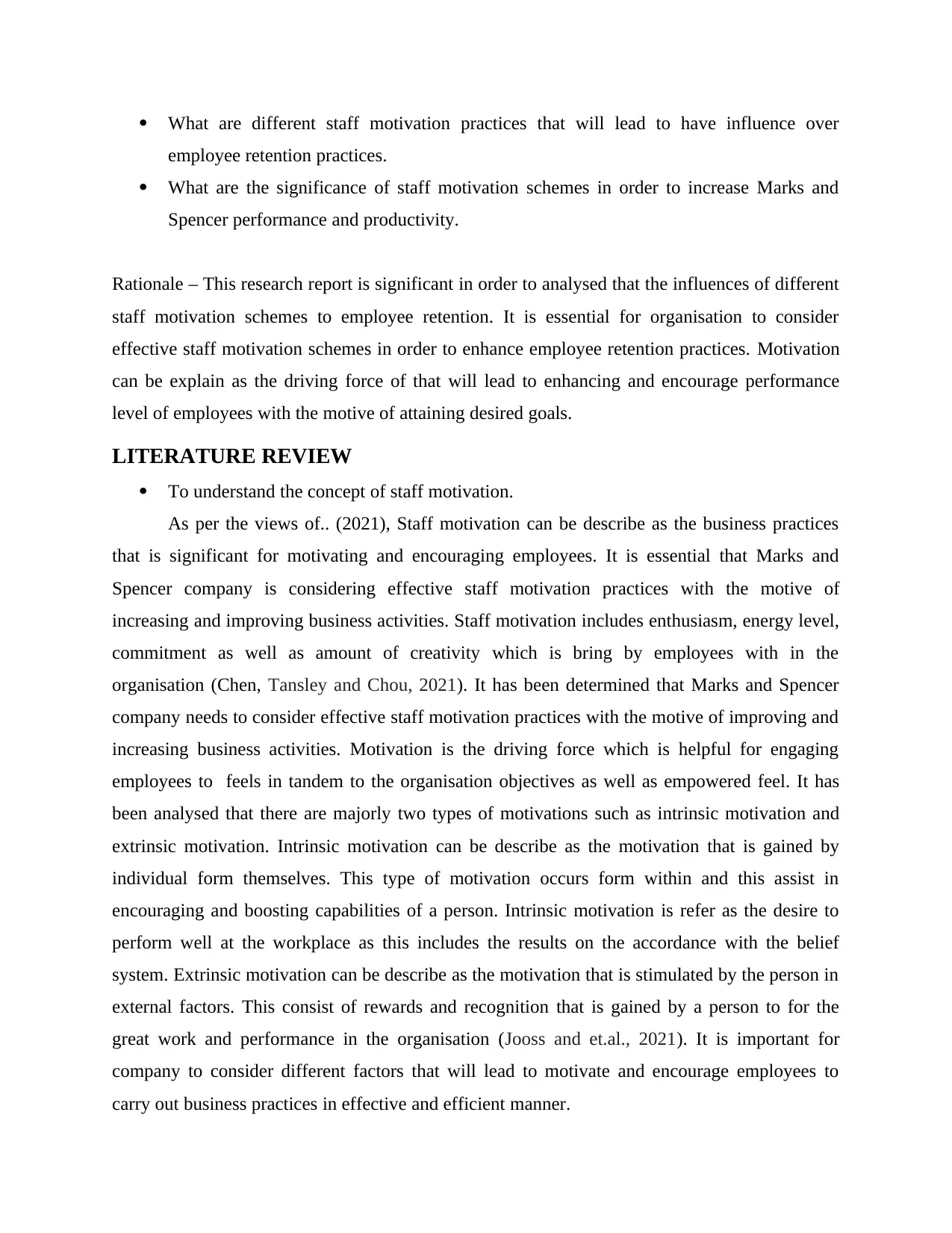
What are different staff motivation practices that will lead to have influence over
employee retention practices.
What are the significance of staff motivation schemes in order to increase Marks and
Spencer performance and productivity.
Rationale – This research report is significant in order to analysed that the influences of different
staff motivation schemes to employee retention. It is essential for organisation to consider
effective staff motivation schemes in order to enhance employee retention practices. Motivation
can be explain as the driving force of that will lead to enhancing and encourage performance
level of employees with the motive of attaining desired goals.
LITERATURE REVIEW
To understand the concept of staff motivation.
As per the views of.. (2021), Staff motivation can be describe as the business practices
that is significant for motivating and encouraging employees. It is essential that Marks and
Spencer company is considering effective staff motivation practices with the motive of
increasing and improving business activities. Staff motivation includes enthusiasm, energy level,
commitment as well as amount of creativity which is bring by employees with in the
organisation (Chen, Tansley and Chou, 2021). It has been determined that Marks and Spencer
company needs to consider effective staff motivation practices with the motive of improving and
increasing business activities. Motivation is the driving force which is helpful for engaging
employees to feels in tandem to the organisation objectives as well as empowered feel. It has
been analysed that there are majorly two types of motivations such as intrinsic motivation and
extrinsic motivation. Intrinsic motivation can be describe as the motivation that is gained by
individual form themselves. This type of motivation occurs form within and this assist in
encouraging and boosting capabilities of a person. Intrinsic motivation is refer as the desire to
perform well at the workplace as this includes the results on the accordance with the belief
system. Extrinsic motivation can be describe as the motivation that is stimulated by the person in
external factors. This consist of rewards and recognition that is gained by a person to for the
great work and performance in the organisation (Jooss and et.al., 2021). It is important for
company to consider different factors that will lead to motivate and encourage employees to
carry out business practices in effective and efficient manner.
employee retention practices.
What are the significance of staff motivation schemes in order to increase Marks and
Spencer performance and productivity.
Rationale – This research report is significant in order to analysed that the influences of different
staff motivation schemes to employee retention. It is essential for organisation to consider
effective staff motivation schemes in order to enhance employee retention practices. Motivation
can be explain as the driving force of that will lead to enhancing and encourage performance
level of employees with the motive of attaining desired goals.
LITERATURE REVIEW
To understand the concept of staff motivation.
As per the views of.. (2021), Staff motivation can be describe as the business practices
that is significant for motivating and encouraging employees. It is essential that Marks and
Spencer company is considering effective staff motivation practices with the motive of
increasing and improving business activities. Staff motivation includes enthusiasm, energy level,
commitment as well as amount of creativity which is bring by employees with in the
organisation (Chen, Tansley and Chou, 2021). It has been determined that Marks and Spencer
company needs to consider effective staff motivation practices with the motive of improving and
increasing business activities. Motivation is the driving force which is helpful for engaging
employees to feels in tandem to the organisation objectives as well as empowered feel. It has
been analysed that there are majorly two types of motivations such as intrinsic motivation and
extrinsic motivation. Intrinsic motivation can be describe as the motivation that is gained by
individual form themselves. This type of motivation occurs form within and this assist in
encouraging and boosting capabilities of a person. Intrinsic motivation is refer as the desire to
perform well at the workplace as this includes the results on the accordance with the belief
system. Extrinsic motivation can be describe as the motivation that is stimulated by the person in
external factors. This consist of rewards and recognition that is gained by a person to for the
great work and performance in the organisation (Jooss and et.al., 2021). It is important for
company to consider different factors that will lead to motivate and encourage employees to
carry out business practices in effective and efficient manner.
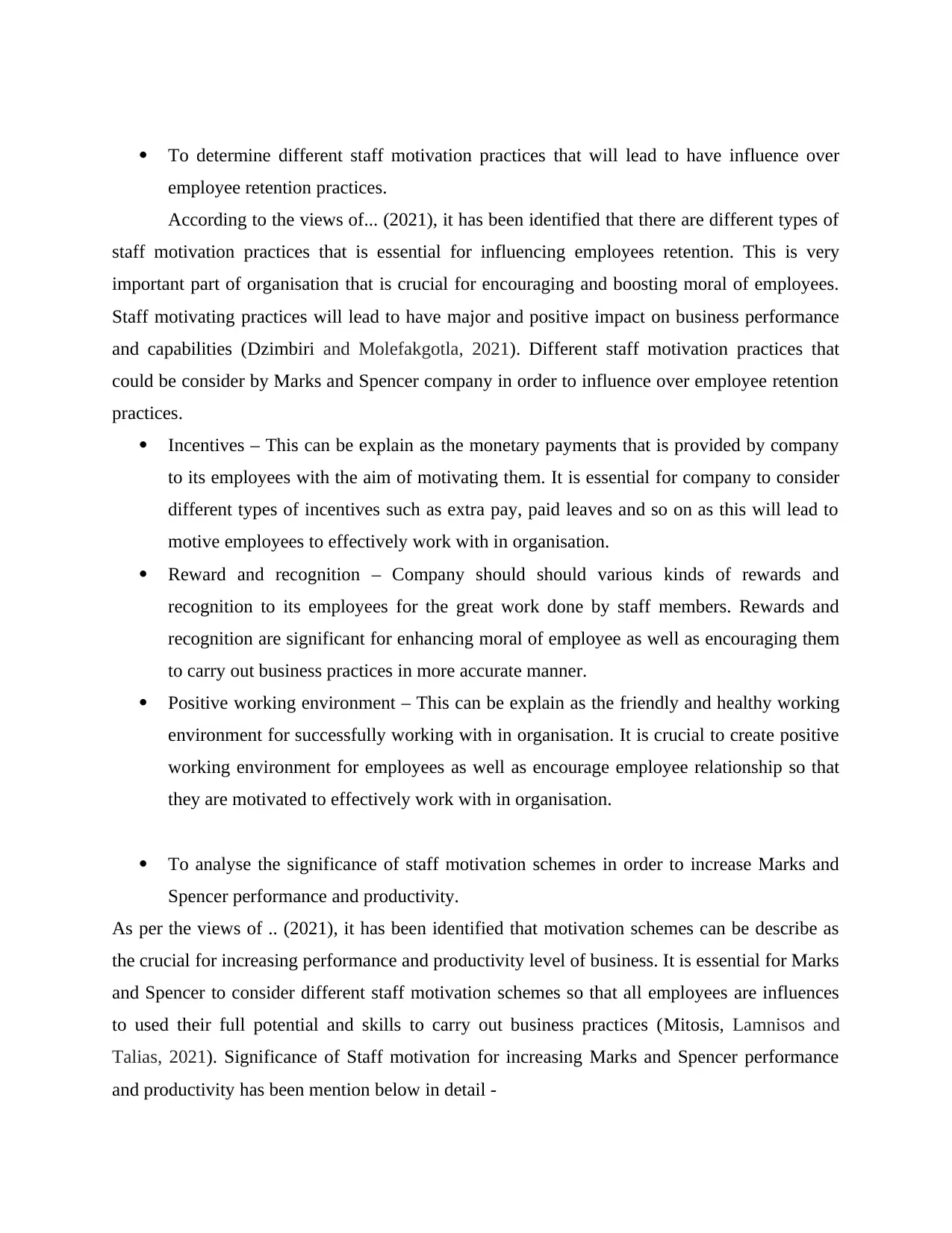
To determine different staff motivation practices that will lead to have influence over
employee retention practices.
According to the views of... (2021), it has been identified that there are different types of
staff motivation practices that is essential for influencing employees retention. This is very
important part of organisation that is crucial for encouraging and boosting moral of employees.
Staff motivating practices will lead to have major and positive impact on business performance
and capabilities (Dzimbiri and Molefakgotla, 2021). Different staff motivation practices that
could be consider by Marks and Spencer company in order to influence over employee retention
practices.
Incentives – This can be explain as the monetary payments that is provided by company
to its employees with the aim of motivating them. It is essential for company to consider
different types of incentives such as extra pay, paid leaves and so on as this will lead to
motive employees to effectively work with in organisation.
Reward and recognition – Company should should various kinds of rewards and
recognition to its employees for the great work done by staff members. Rewards and
recognition are significant for enhancing moral of employee as well as encouraging them
to carry out business practices in more accurate manner.
Positive working environment – This can be explain as the friendly and healthy working
environment for successfully working with in organisation. It is crucial to create positive
working environment for employees as well as encourage employee relationship so that
they are motivated to effectively work with in organisation.
To analyse the significance of staff motivation schemes in order to increase Marks and
Spencer performance and productivity.
As per the views of .. (2021), it has been identified that motivation schemes can be describe as
the crucial for increasing performance and productivity level of business. It is essential for Marks
and Spencer to consider different staff motivation schemes so that all employees are influences
to used their full potential and skills to carry out business practices (Mitosis, Lamnisos and
Talias, 2021). Significance of Staff motivation for increasing Marks and Spencer performance
and productivity has been mention below in detail -
employee retention practices.
According to the views of... (2021), it has been identified that there are different types of
staff motivation practices that is essential for influencing employees retention. This is very
important part of organisation that is crucial for encouraging and boosting moral of employees.
Staff motivating practices will lead to have major and positive impact on business performance
and capabilities (Dzimbiri and Molefakgotla, 2021). Different staff motivation practices that
could be consider by Marks and Spencer company in order to influence over employee retention
practices.
Incentives – This can be explain as the monetary payments that is provided by company
to its employees with the aim of motivating them. It is essential for company to consider
different types of incentives such as extra pay, paid leaves and so on as this will lead to
motive employees to effectively work with in organisation.
Reward and recognition – Company should should various kinds of rewards and
recognition to its employees for the great work done by staff members. Rewards and
recognition are significant for enhancing moral of employee as well as encouraging them
to carry out business practices in more accurate manner.
Positive working environment – This can be explain as the friendly and healthy working
environment for successfully working with in organisation. It is crucial to create positive
working environment for employees as well as encourage employee relationship so that
they are motivated to effectively work with in organisation.
To analyse the significance of staff motivation schemes in order to increase Marks and
Spencer performance and productivity.
As per the views of .. (2021), it has been identified that motivation schemes can be describe as
the crucial for increasing performance and productivity level of business. It is essential for Marks
and Spencer to consider different staff motivation schemes so that all employees are influences
to used their full potential and skills to carry out business practices (Mitosis, Lamnisos and
Talias, 2021). Significance of Staff motivation for increasing Marks and Spencer performance
and productivity has been mention below in detail -
⊘ This is a preview!⊘
Do you want full access?
Subscribe today to unlock all pages.

Trusted by 1+ million students worldwide
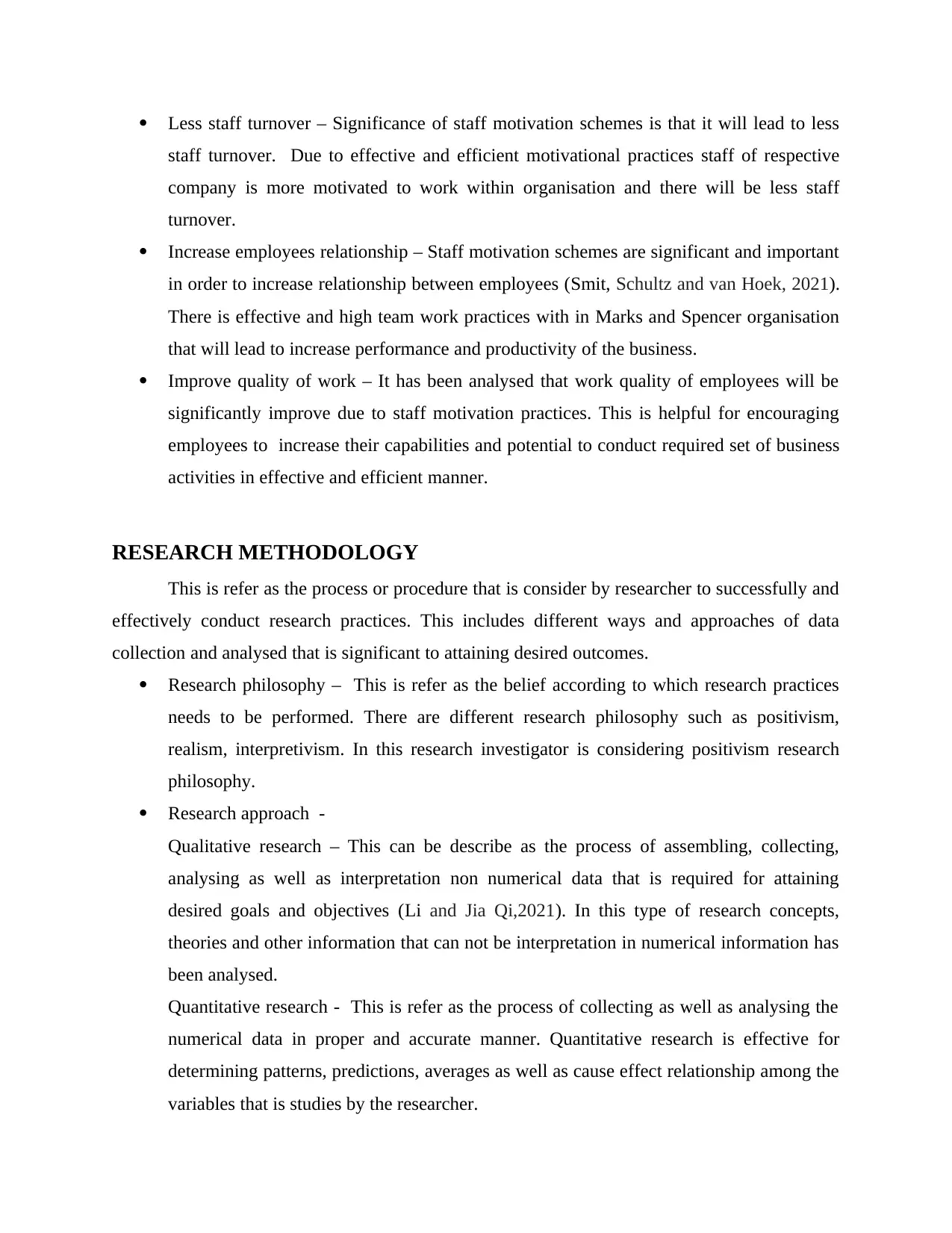
Less staff turnover – Significance of staff motivation schemes is that it will lead to less
staff turnover. Due to effective and efficient motivational practices staff of respective
company is more motivated to work within organisation and there will be less staff
turnover.
Increase employees relationship – Staff motivation schemes are significant and important
in order to increase relationship between employees (Smit, Schultz and van Hoek, 2021).
There is effective and high team work practices with in Marks and Spencer organisation
that will lead to increase performance and productivity of the business.
Improve quality of work – It has been analysed that work quality of employees will be
significantly improve due to staff motivation practices. This is helpful for encouraging
employees to increase their capabilities and potential to conduct required set of business
activities in effective and efficient manner.
RESEARCH METHODOLOGY
This is refer as the process or procedure that is consider by researcher to successfully and
effectively conduct research practices. This includes different ways and approaches of data
collection and analysed that is significant to attaining desired outcomes.
Research philosophy – This is refer as the belief according to which research practices
needs to be performed. There are different research philosophy such as positivism,
realism, interpretivism. In this research investigator is considering positivism research
philosophy.
Research approach -
Qualitative research – This can be describe as the process of assembling, collecting,
analysing as well as interpretation non numerical data that is required for attaining
desired goals and objectives (Li and Jia Qi,2021). In this type of research concepts,
theories and other information that can not be interpretation in numerical information has
been analysed.
Quantitative research - This is refer as the process of collecting as well as analysing the
numerical data in proper and accurate manner. Quantitative research is effective for
determining patterns, predictions, averages as well as cause effect relationship among the
variables that is studies by the researcher.
staff turnover. Due to effective and efficient motivational practices staff of respective
company is more motivated to work within organisation and there will be less staff
turnover.
Increase employees relationship – Staff motivation schemes are significant and important
in order to increase relationship between employees (Smit, Schultz and van Hoek, 2021).
There is effective and high team work practices with in Marks and Spencer organisation
that will lead to increase performance and productivity of the business.
Improve quality of work – It has been analysed that work quality of employees will be
significantly improve due to staff motivation practices. This is helpful for encouraging
employees to increase their capabilities and potential to conduct required set of business
activities in effective and efficient manner.
RESEARCH METHODOLOGY
This is refer as the process or procedure that is consider by researcher to successfully and
effectively conduct research practices. This includes different ways and approaches of data
collection and analysed that is significant to attaining desired outcomes.
Research philosophy – This is refer as the belief according to which research practices
needs to be performed. There are different research philosophy such as positivism,
realism, interpretivism. In this research investigator is considering positivism research
philosophy.
Research approach -
Qualitative research – This can be describe as the process of assembling, collecting,
analysing as well as interpretation non numerical data that is required for attaining
desired goals and objectives (Li and Jia Qi,2021). In this type of research concepts,
theories and other information that can not be interpretation in numerical information has
been analysed.
Quantitative research - This is refer as the process of collecting as well as analysing the
numerical data in proper and accurate manner. Quantitative research is effective for
determining patterns, predictions, averages as well as cause effect relationship among the
variables that is studies by the researcher.
Paraphrase This Document
Need a fresh take? Get an instant paraphrase of this document with our AI Paraphraser
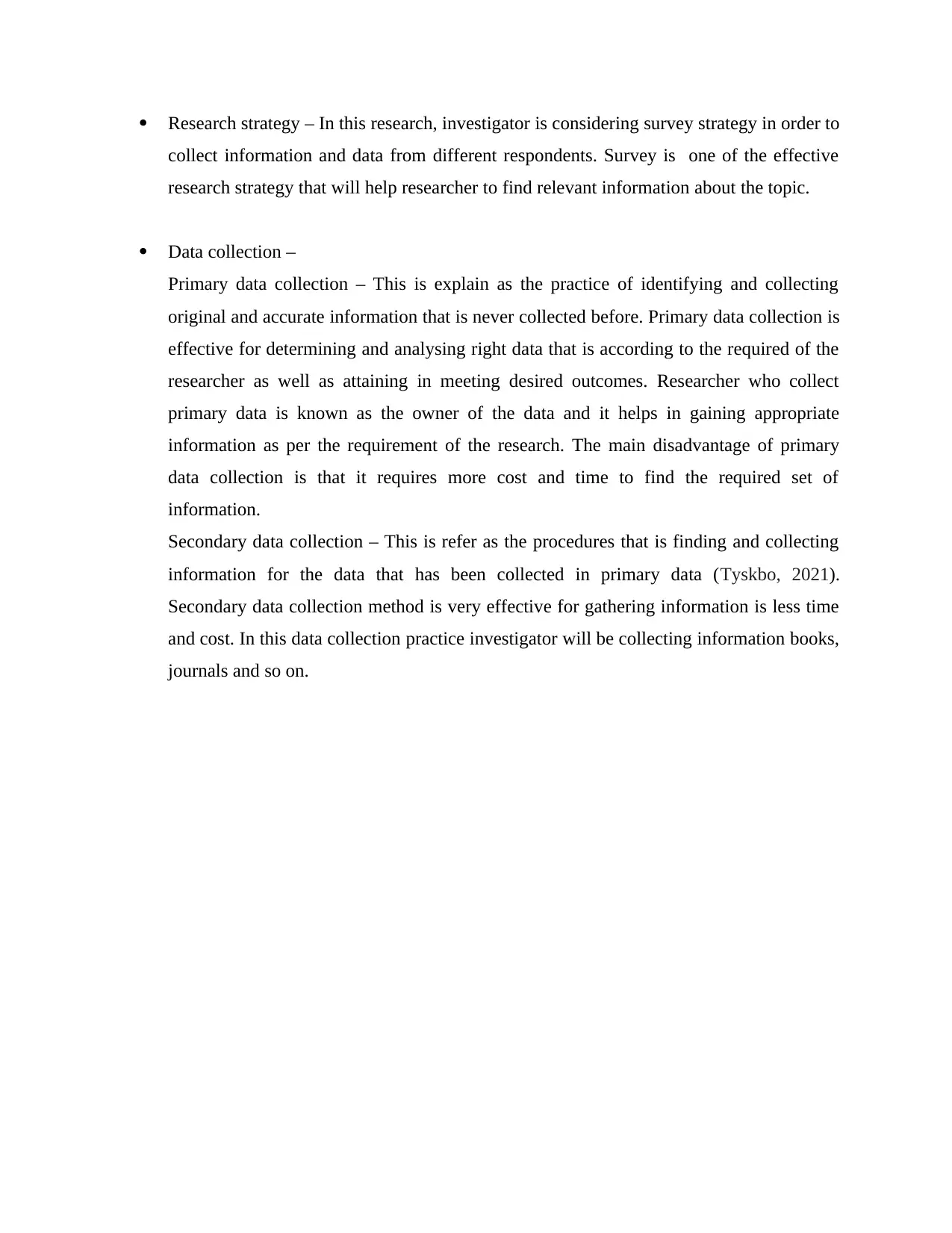
Research strategy – In this research, investigator is considering survey strategy in order to
collect information and data from different respondents. Survey is one of the effective
research strategy that will help researcher to find relevant information about the topic.
Data collection –
Primary data collection – This is explain as the practice of identifying and collecting
original and accurate information that is never collected before. Primary data collection is
effective for determining and analysing right data that is according to the required of the
researcher as well as attaining in meeting desired outcomes. Researcher who collect
primary data is known as the owner of the data and it helps in gaining appropriate
information as per the requirement of the research. The main disadvantage of primary
data collection is that it requires more cost and time to find the required set of
information.
Secondary data collection – This is refer as the procedures that is finding and collecting
information for the data that has been collected in primary data (Tyskbo, 2021).
Secondary data collection method is very effective for gathering information is less time
and cost. In this data collection practice investigator will be collecting information books,
journals and so on.
collect information and data from different respondents. Survey is one of the effective
research strategy that will help researcher to find relevant information about the topic.
Data collection –
Primary data collection – This is explain as the practice of identifying and collecting
original and accurate information that is never collected before. Primary data collection is
effective for determining and analysing right data that is according to the required of the
researcher as well as attaining in meeting desired outcomes. Researcher who collect
primary data is known as the owner of the data and it helps in gaining appropriate
information as per the requirement of the research. The main disadvantage of primary
data collection is that it requires more cost and time to find the required set of
information.
Secondary data collection – This is refer as the procedures that is finding and collecting
information for the data that has been collected in primary data (Tyskbo, 2021).
Secondary data collection method is very effective for gathering information is less time
and cost. In this data collection practice investigator will be collecting information books,
journals and so on.
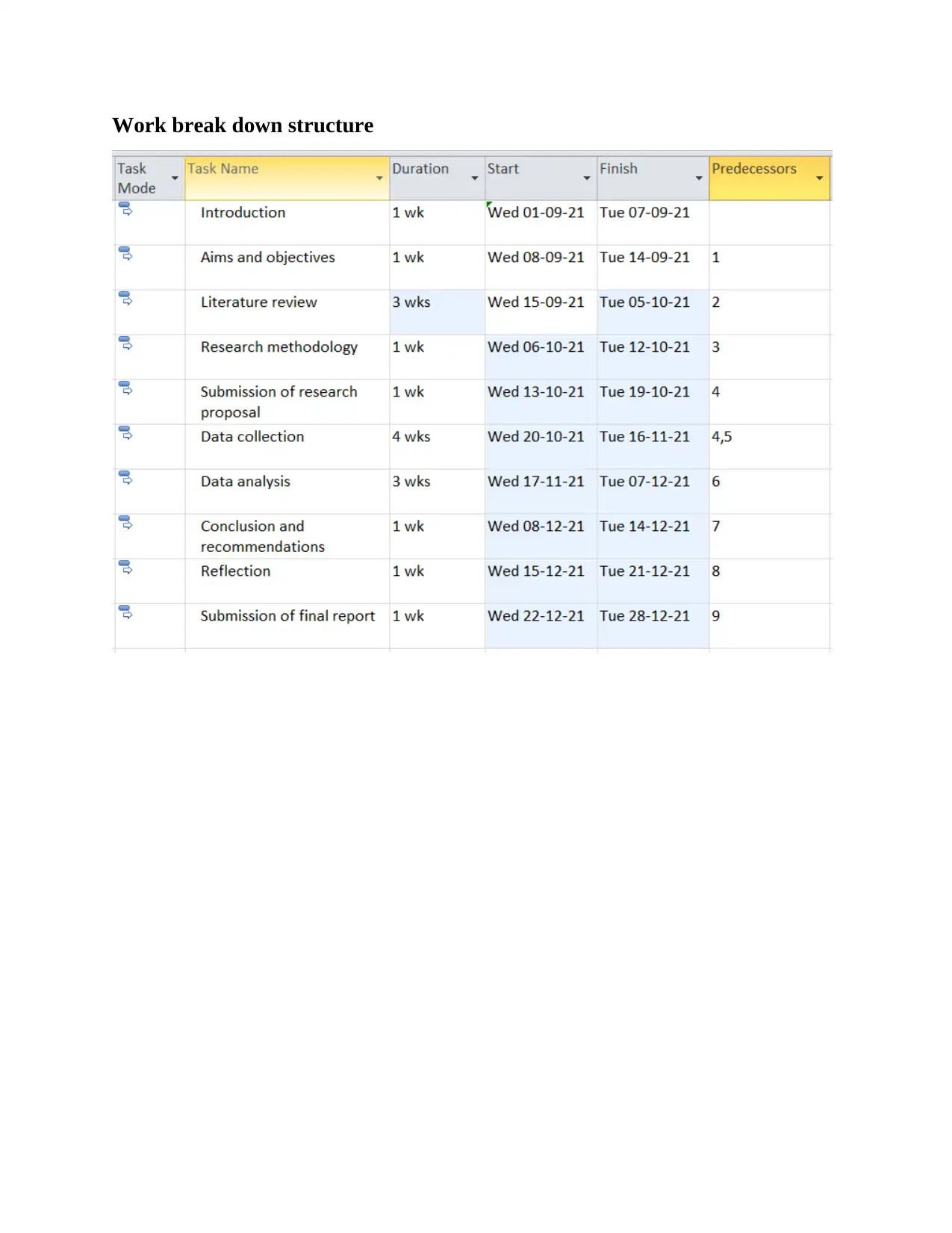
Work break down structure
⊘ This is a preview!⊘
Do you want full access?
Subscribe today to unlock all pages.

Trusted by 1+ million students worldwide
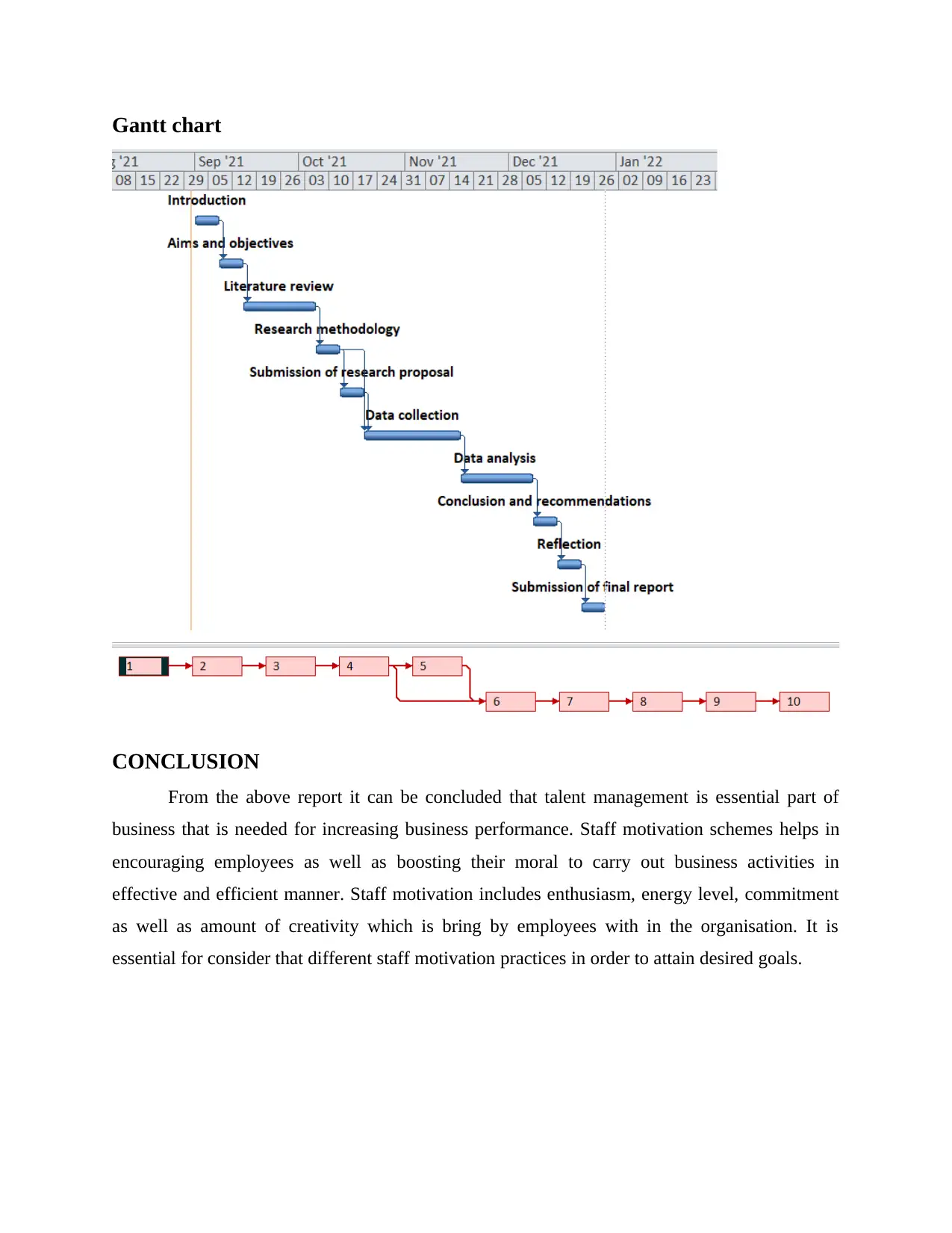
Gantt chart
CONCLUSION
From the above report it can be concluded that talent management is essential part of
business that is needed for increasing business performance. Staff motivation schemes helps in
encouraging employees as well as boosting their moral to carry out business activities in
effective and efficient manner. Staff motivation includes enthusiasm, energy level, commitment
as well as amount of creativity which is bring by employees with in the organisation. It is
essential for consider that different staff motivation practices in order to attain desired goals.
CONCLUSION
From the above report it can be concluded that talent management is essential part of
business that is needed for increasing business performance. Staff motivation schemes helps in
encouraging employees as well as boosting their moral to carry out business activities in
effective and efficient manner. Staff motivation includes enthusiasm, energy level, commitment
as well as amount of creativity which is bring by employees with in the organisation. It is
essential for consider that different staff motivation practices in order to attain desired goals.
Paraphrase This Document
Need a fresh take? Get an instant paraphrase of this document with our AI Paraphraser
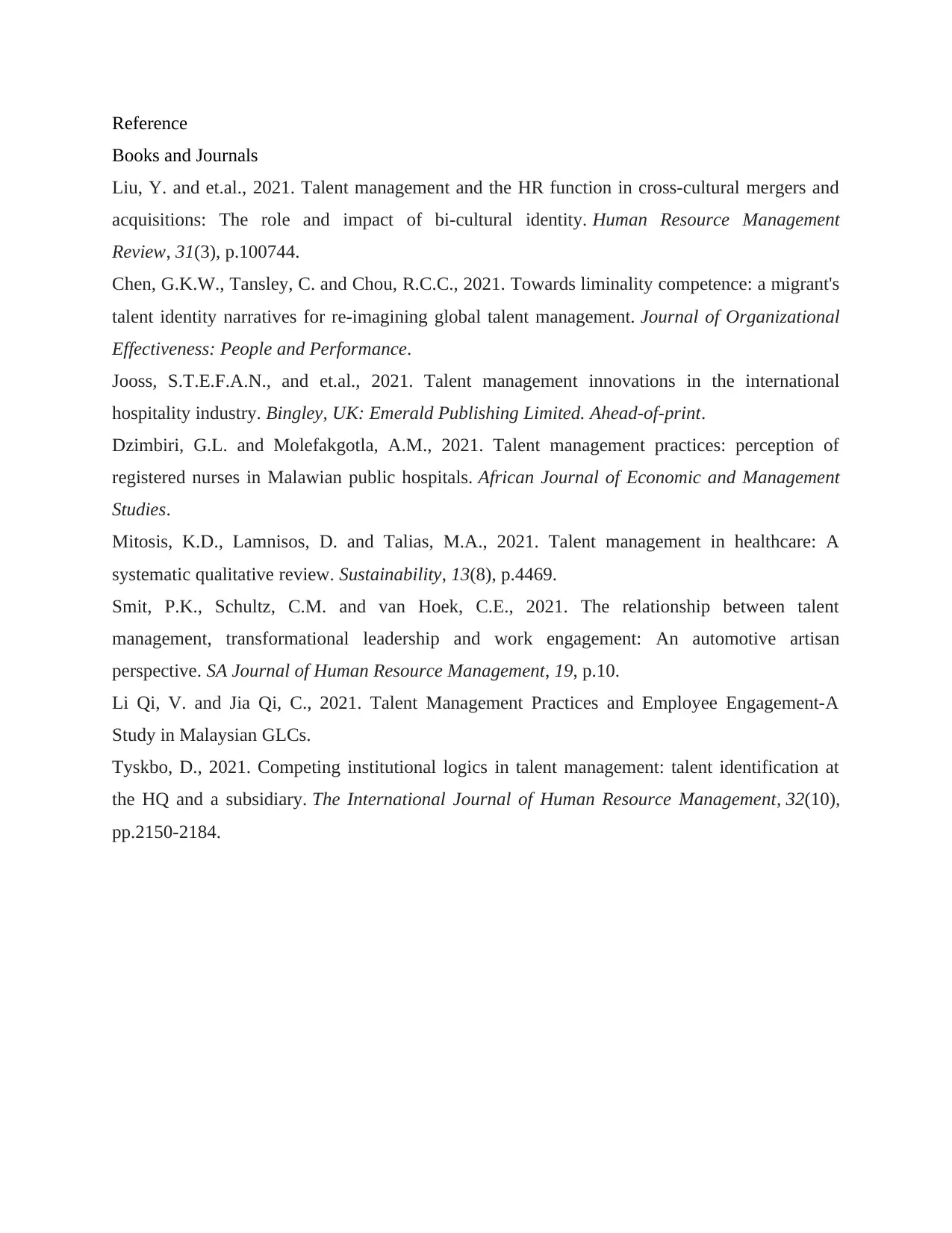
Reference
Books and Journals
Liu, Y. and et.al., 2021. Talent management and the HR function in cross-cultural mergers and
acquisitions: The role and impact of bi-cultural identity. Human Resource Management
Review, 31(3), p.100744.
Chen, G.K.W., Tansley, C. and Chou, R.C.C., 2021. Towards liminality competence: a migrant's
talent identity narratives for re-imagining global talent management. Journal of Organizational
Effectiveness: People and Performance.
Jooss, S.T.E.F.A.N., and et.al., 2021. Talent management innovations in the international
hospitality industry. Bingley, UK: Emerald Publishing Limited. Ahead-of-print.
Dzimbiri, G.L. and Molefakgotla, A.M., 2021. Talent management practices: perception of
registered nurses in Malawian public hospitals. African Journal of Economic and Management
Studies.
Mitosis, K.D., Lamnisos, D. and Talias, M.A., 2021. Talent management in healthcare: A
systematic qualitative review. Sustainability, 13(8), p.4469.
Smit, P.K., Schultz, C.M. and van Hoek, C.E., 2021. The relationship between talent
management, transformational leadership and work engagement: An automotive artisan
perspective. SA Journal of Human Resource Management, 19, p.10.
Li Qi, V. and Jia Qi, C., 2021. Talent Management Practices and Employee Engagement-A
Study in Malaysian GLCs.
Tyskbo, D., 2021. Competing institutional logics in talent management: talent identification at
the HQ and a subsidiary. The International Journal of Human Resource Management, 32(10),
pp.2150-2184.
Books and Journals
Liu, Y. and et.al., 2021. Talent management and the HR function in cross-cultural mergers and
acquisitions: The role and impact of bi-cultural identity. Human Resource Management
Review, 31(3), p.100744.
Chen, G.K.W., Tansley, C. and Chou, R.C.C., 2021. Towards liminality competence: a migrant's
talent identity narratives for re-imagining global talent management. Journal of Organizational
Effectiveness: People and Performance.
Jooss, S.T.E.F.A.N., and et.al., 2021. Talent management innovations in the international
hospitality industry. Bingley, UK: Emerald Publishing Limited. Ahead-of-print.
Dzimbiri, G.L. and Molefakgotla, A.M., 2021. Talent management practices: perception of
registered nurses in Malawian public hospitals. African Journal of Economic and Management
Studies.
Mitosis, K.D., Lamnisos, D. and Talias, M.A., 2021. Talent management in healthcare: A
systematic qualitative review. Sustainability, 13(8), p.4469.
Smit, P.K., Schultz, C.M. and van Hoek, C.E., 2021. The relationship between talent
management, transformational leadership and work engagement: An automotive artisan
perspective. SA Journal of Human Resource Management, 19, p.10.
Li Qi, V. and Jia Qi, C., 2021. Talent Management Practices and Employee Engagement-A
Study in Malaysian GLCs.
Tyskbo, D., 2021. Competing institutional logics in talent management: talent identification at
the HQ and a subsidiary. The International Journal of Human Resource Management, 32(10),
pp.2150-2184.
1 out of 11
Related Documents
Your All-in-One AI-Powered Toolkit for Academic Success.
+13062052269
info@desklib.com
Available 24*7 on WhatsApp / Email
![[object Object]](/_next/static/media/star-bottom.7253800d.svg)
Unlock your academic potential
Copyright © 2020–2025 A2Z Services. All Rights Reserved. Developed and managed by ZUCOL.



